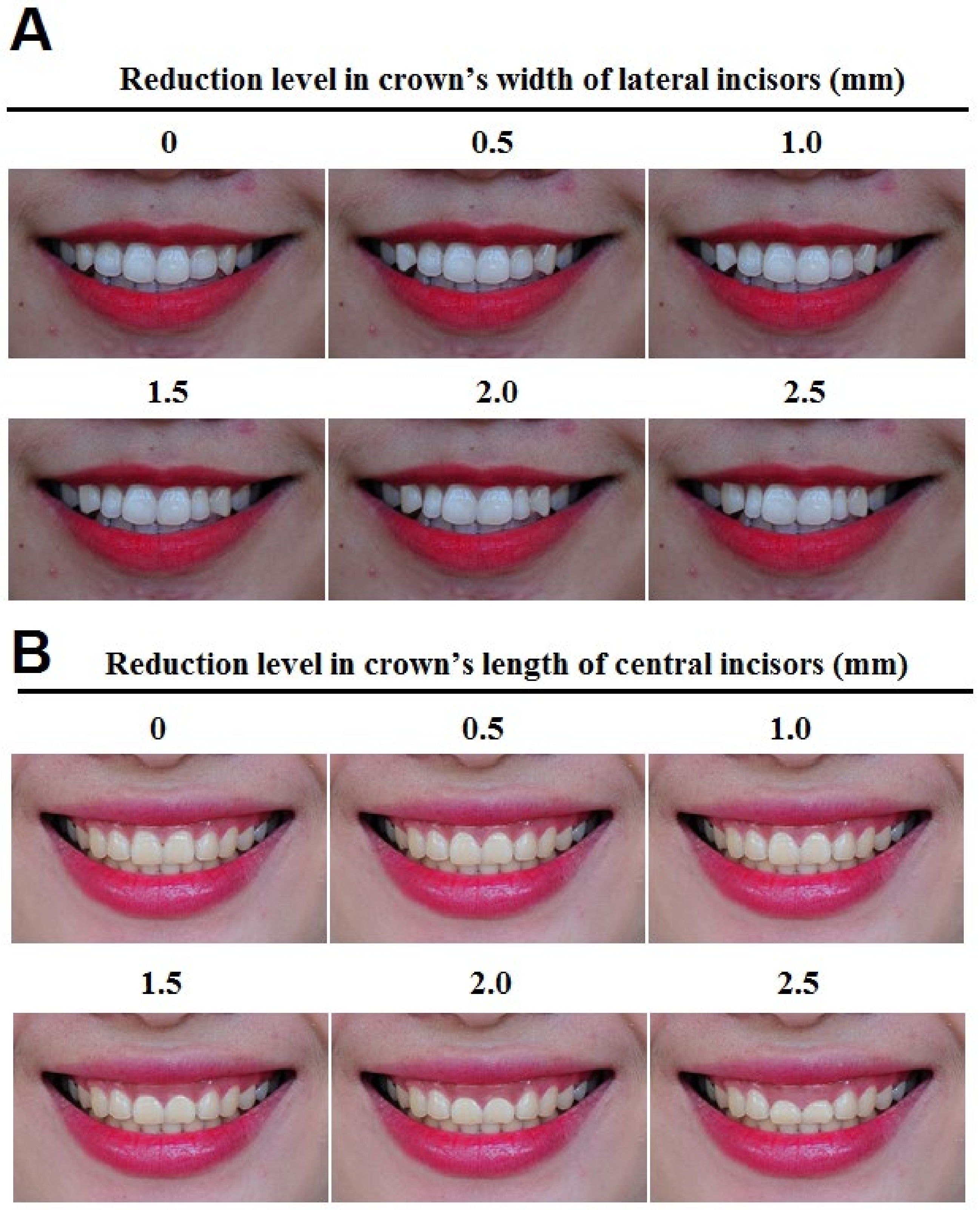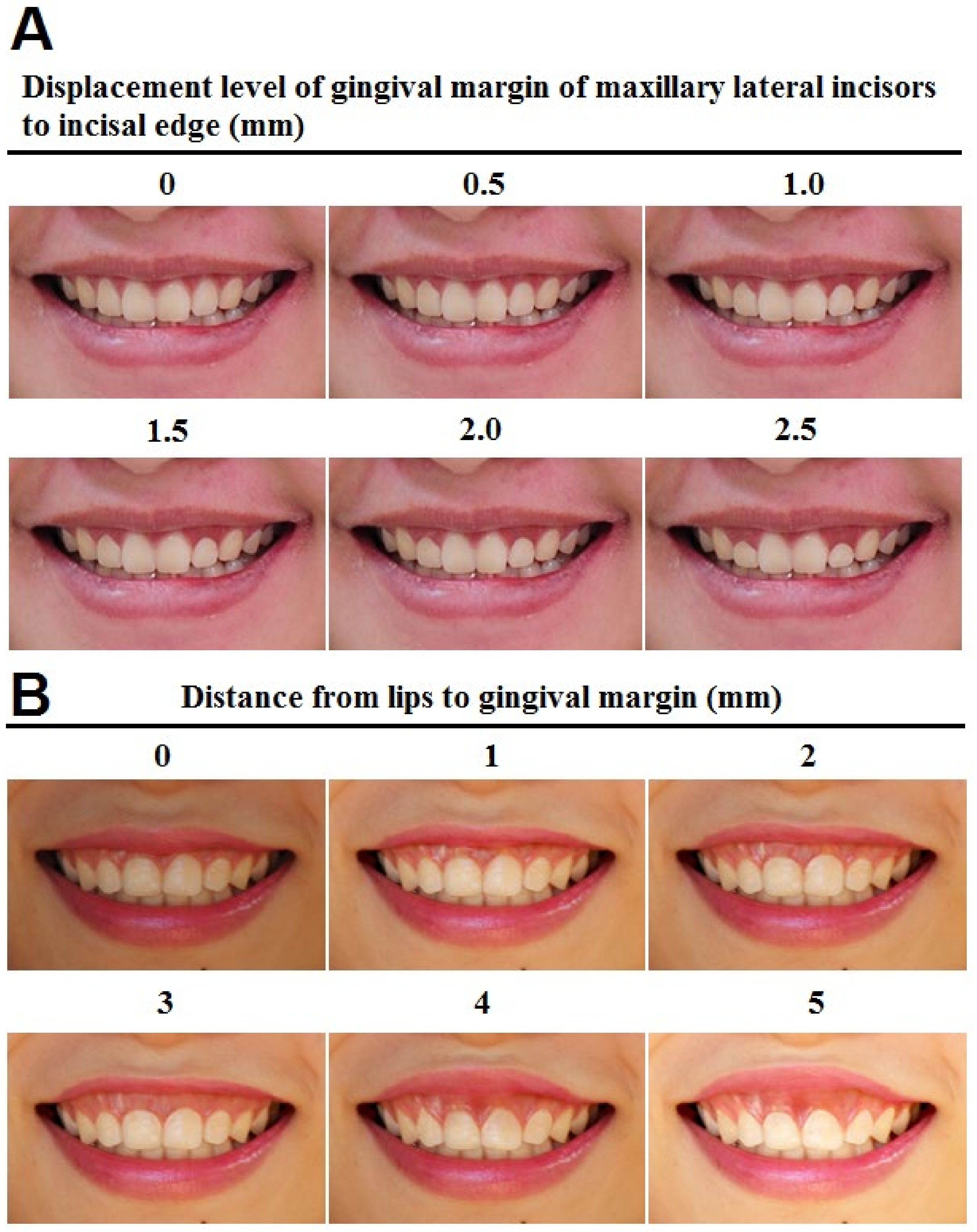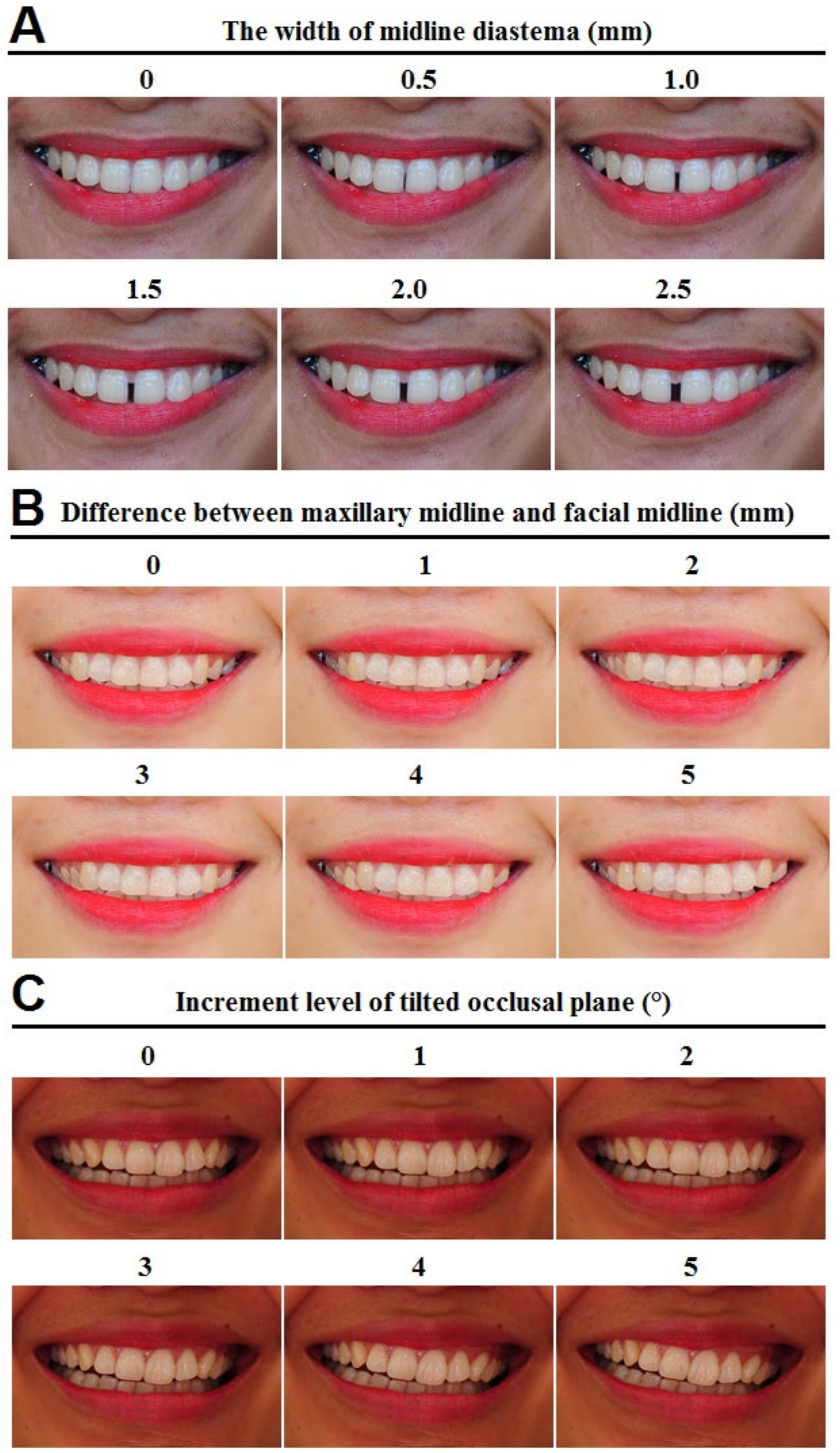Perceptions of Dentists and Non-Professionals on Some Dental Factors Affecting Smile Aesthetics: A Study from Vietnam
Abstract
1. Introduction
2. Materials and Methods
2.1. Materials
Selective Criteria
2.2. Method
Study Procedure
2.3. Research Ethics
2.4. Statistical Analysis
3. Results
3.1. The Effect of Alterations of the Crown Width/Length of the Maxillary Lateral/Central Incisors on Aesthetic Perceptions between Studied Groups
3.2. The Effect of Alterations of the Gingival Margin Position of Maxillary Lateral Incisors or Gingival Exposure Level on Aesthetic Perceptions between Studied Groups
3.3. The Effect of Alterations of the Maxillary Midline Diastema, Maxillary Midline Shift, and Tilted Occlusal Plane on Aesthetic Perceptions between Studied Groups
4. Discussion
5. Conclusions
Author Contributions
Funding
Acknowledgments
Conflicts of Interest
References
- Menezes, E.B.C.; Bittencourt, M.A.V.; Machado, A.W. Do different vertical positions of maxillary central incisors influence smile esthetics perception? Dent. Press J. Orthod. 2017, 22, 95–105. [Google Scholar] [CrossRef] [PubMed]
- Betrine Ribeiro, J.; Alecrim Figueiredo, B.; Wilson Machado, A. Does the presence of unilateral maxillary incisor edge asymmetries influence the perception of smile esthetics? J. Esthet. Restor. Dent. 2017, 29, 291–297. [Google Scholar] [CrossRef] [PubMed]
- Kaya, B.; Uyar, R. The impact of occlusal plane cant along with gingival display on smile attractiveness. Orthod. Craniofacial Res. 2016, 19, 93–101. [Google Scholar] [CrossRef]
- Kaya, B.; Uyar, R. Influence on smile attractiveness of the smile arc in conjunction with gingival display. Am. J. Orthod. Dentofac. Orthop. 2013, 144, 541–547. [Google Scholar] [CrossRef]
- Talic, N.; AlOmar, S.; AlMaidhan, A. Perception of Saudi dentists and lay people to altered smile esthetics. Saudi Dent. J. 2013, 25, 13–21. [Google Scholar] [CrossRef] [PubMed]
- Ousehal, L.; Aghoutan, H.; Chemlali, S.; Anssari, I.F.; Talic, N. Perception of altered smile esthetics among Moroccan professionals and lay people. Saudi Dent. J. 2016, 28, 174–182. [Google Scholar] [CrossRef] [PubMed]
- Huong, D.M.; Hang, L.T.T.; Nhu Ngoc, V.T.; Anh, L.Q.; Son, L.H.; Chu, D.-T.; Le, D.-H. Prevalence of early childhood caries and its related risk factors in preschoolers: Result from a cross sectional study in Vietnam. Pediatric Dent. J. 2017, 27, 79–84. [Google Scholar] [CrossRef]
- Kokich, V.O.; Asuman Kiyak, H.; Shapiro, P.A. Comparing the perception of dentists and lay people to altered dental esthetics. J. Esthet. Restor. Dent. 1999, 11, 311–324. [Google Scholar] [CrossRef] [PubMed]
- Rufenacht, C.R. Fundamentals of Esthetics; Quintessence Publishing Co Inc: Batavia, IL, USA, 1990. [Google Scholar]
- Ker, A.J.; Chan, R.; Fields, H.W.; Beck, M.; Rosenstiel, S. Esthetics and smile characteristics from the layperson’s perspective. J. Am. Dent. Assoc. 2008, 139, 1318–1327. [Google Scholar] [CrossRef] [PubMed]
- Pereira Silva, B.; Jiménez-Castellanos, E.; Martinez-de-Fuentes, R.; Greenberg, J.R.; Chu, S. Laypersons’ perception of facial and dental asymmetries. Int. J. Periodontics Restor. Dent. 2013, 33, 162–171. [Google Scholar] [CrossRef] [PubMed]



| Maxillary Incisors—Related Factors | Non-Professionals | Dentists | p | ||
|---|---|---|---|---|---|
| x | SD | x | SD | ||
| Reduction level in crown’s width of lateral incisors (mm) | |||||
| 0 | 69.37 | 17.68 | 65.07 | 15.50 | 0.195 |
| 0.5 | 65.76 | 17.75 | 63.72 | 13.89 | 0.520 |
| 1.0 | 64.27 | 17.85 | 58.47 | 12.87 | 0.063 |
| 1.5 | 65.59 | 17.44 | 59.98 | 15.62 | 0.090 |
| 2.0 | 60.39 | 15.64 | 54.80 | 12.75 | 0.051 |
| 2.5 | 55.78 | 16.89 | 46.62 | 17.09 | 0.008 * |
| Reduction level in crown’s length of central incisors (mm) | |||||
| 0 | 59.39 | 15.07 | 59.76 | 14.32 | 0.898 |
| 0.5 | 52.25 | 17.89 | 54.29 | 15.69 | 0.542 |
| 1.0 | 52.88 | 15.82 | 49.50 | 16.36 | 0.293 |
| 1.5 | 44.35 | 15.88 | 42.11 | 14.11 | 0.454 |
| 2.0 | 31.96 | 15.46 | 33.41 | 14.31 | 0.624 |
| 2.5 | 26.50 | 15.30 | 23.92 | 13.74 | 0.371 |
| Gingival Margin Position | Non-Professionals | Dentists | p | ||
|---|---|---|---|---|---|
| x | SD | x | SD | ||
| Displacement level of gingival margin of maxillary lateral incisors to incisal edge (mm) | |||||
| 0 | 56.94 | 16.15 | 58.07 | 13.55 | 0.701 |
| 0.5 | 60.49 | 14.02 | 60.68 | 13.48 | 0.943 |
| 1.0 | 57.50 | 15.86 | 54.64 | 14.57 | 0.345 |
| 1.5 | 52.92 | 15.20 | 50.98 | 14.25 | 0.508 |
| 2.0 | 55.33 | 12.95 | 53.66 | 14.88 | 0.548 |
| 2.5 | 41.07 | 18.12 | 39.25 | 17.23 | 0.604 |
| Distance from lips to gingival margin (mm) | |||||
| 0 | 61.51 | 15.43 | 61.90 | 14.37 | 0.895 |
| 1 | 51.53 | 16.20 | 48.92 | 12.03 | 0.358 |
| 2 | 46.67 | 16.81 | 40.43 | 10.09 | 0.025 * |
| 3 | 43.61 | 18.68 | 35.71 | 12.25 | 0.013 * |
| 4 | 39.00 | 16.24 | 34.49 | 14.00 | 0.136 |
| 5 | 36.35 | 15.64 | 29.65 | 13.48 | 0.022 * |
| Midline Factors | Non-Professionals | Dentists | p | ||
|---|---|---|---|---|---|
| x | SD | x | SD | ||
| The width of midline diastema (mm) | |||||
| 0 | 61.53 | 18.48 | 56.57 | 17.48 | 0.167 |
| 0.5 | 51.02 | 16.90 | 48.41 | 15.46 | 0.418 |
| 1.0 | 37.71 | 16.15 | 40.96 | 14.48 | 0.287 |
| 1.5 | 32.24 | 14.38 | 33.88 | 13.84 | 0.557 |
| 2.0 | 30.29 | 13.17 | 32.67 | 11.96 | 0.343 |
| 2.5 | 25.80 | 12.74 | 25.92 | 12.19 | 0.962 |
| Difference between maxillary midline and facial midline (mm) | |||||
| 0 | 61.98 | 15.51 | 58.18 | 17.38 | 0.246 |
| 1 | 59.96 | 15.68 | 58.27 | 14.32 | 0.572 |
| 2 | 58.02 | 16.96 | 54.18 | 15.62 | 0.237 |
| 3 | 59.35 | 17.60 | 56.06 | 15.77 | 0.322 |
| 4 | 54.92 | 16.94 | 53.51 | 15.05 | 0.657 |
| 5 | 54.20 | 18.14 | 49.14 | 19.03 | 0.172 |
| Tilted Occlusal Plane (°) | Non-Professionals | (Dentists) | p | ||
|---|---|---|---|---|---|
| x | SD | x | SD | ||
| 0 | 53.27 | 15.75 | 52.47 | 15.45 | 0.795 |
| 1 | 51.16 | 16.35 | 52.02 | 15.37 | 0.784 |
| 2 | 53.06 | 12.23 | 52.75 | 15.25 | 0.909 |
| 3 | 48.02 | 14.68 | 45.02 | 15.56 | 0.319 |
| 4 | 42.82 | 18.69 | 37.90 | 16.83 | 0.165 |
| 5 | 38.09 | 15.90 | 32.37 | 15.33 | 0.067 |
© 2020 by the authors. Licensee MDPI, Basel, Switzerland. This article is an open access article distributed under the terms and conditions of the Creative Commons Attribution (CC BY) license (http://creativecommons.org/licenses/by/4.0/).
Share and Cite
Ngoc, V.T.N.; Tran, D.-K.; Dung, T.M.; Anh, N.V.; Nga, V.T.; Anh, L.Q.; Hanh, N.T.T.; Linh, N.P.; Quynh, H.N.; Chu, D.T. Perceptions of Dentists and Non-Professionals on Some Dental Factors Affecting Smile Aesthetics: A Study from Vietnam. Int. J. Environ. Res. Public Health 2020, 17, 1638. https://doi.org/10.3390/ijerph17051638
Ngoc VTN, Tran D-K, Dung TM, Anh NV, Nga VT, Anh LQ, Hanh NTT, Linh NP, Quynh HN, Chu DT. Perceptions of Dentists and Non-Professionals on Some Dental Factors Affecting Smile Aesthetics: A Study from Vietnam. International Journal of Environmental Research and Public Health. 2020; 17(5):1638. https://doi.org/10.3390/ijerph17051638
Chicago/Turabian StyleNgoc, Vo Truong Nhu, Dang-Khoa Tran, Truong Manh Dung, Nguyen Viet Anh, Vu Thi Nga, Le Quynh Anh, Nguyen Thi Thuy Hanh, Nguyen Phuong Linh, Hoang Ngoc Quynh, and Dinh Toi Chu. 2020. "Perceptions of Dentists and Non-Professionals on Some Dental Factors Affecting Smile Aesthetics: A Study from Vietnam" International Journal of Environmental Research and Public Health 17, no. 5: 1638. https://doi.org/10.3390/ijerph17051638
APA StyleNgoc, V. T. N., Tran, D.-K., Dung, T. M., Anh, N. V., Nga, V. T., Anh, L. Q., Hanh, N. T. T., Linh, N. P., Quynh, H. N., & Chu, D. T. (2020). Perceptions of Dentists and Non-Professionals on Some Dental Factors Affecting Smile Aesthetics: A Study from Vietnam. International Journal of Environmental Research and Public Health, 17(5), 1638. https://doi.org/10.3390/ijerph17051638






